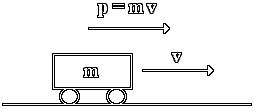Linear Momentum
Linear Momentum
Linear momentum, denoted by the letter p, is a vector quantity which represents the product of an object's velocity, v, and mass, m, as it moves along a straight line. As a vector quantity, an object's linear momentum possesses momentum and direction and is therefore always in the same direction as its velocity vector. Linear momentum can be expressed by the equation: p = mv
When an object is moving, it has a non-zero momentum. If an object is standing still, then its momentum is zero.
By Newton's Second Law, F=ma, the conservation of linear momentum is supported. Since acceleration can be expressed as ∆v/∆t, Newton's Second Law could therefore be expressed as F = m∆v/∆t. Since m∆v is equal to momentum, p, an expression of Newton's Second Law can be expressed in terms of momentum as F=∆p/∆t. In many ways, this expression of Newton's Second Law is more versatile than the equation F=ma, because it can be used to analyze systems where the velocity changes and the mass of a body changes. For instance, it can be applied to a motorcycle burning fuel by taking in to account not only the velocity change, but also the change in the mass of the body, which in this case would be the fuel burning and thus lowering the total body mass of the motorcycle.
Newton's laws of motion also play a role in supporting the law of conservation of linear momentum. Linear momentum is a conserved quantity, and therefore in a closed system (a system that does not allow transfers of mass or energy into or out of the system), the total momentum of the system will not change. This allows one to calculate and predict the outcomes when objects bounce into one another. Or, by knowing the outcome of a collision, one can reason what was the initial state of the system.
